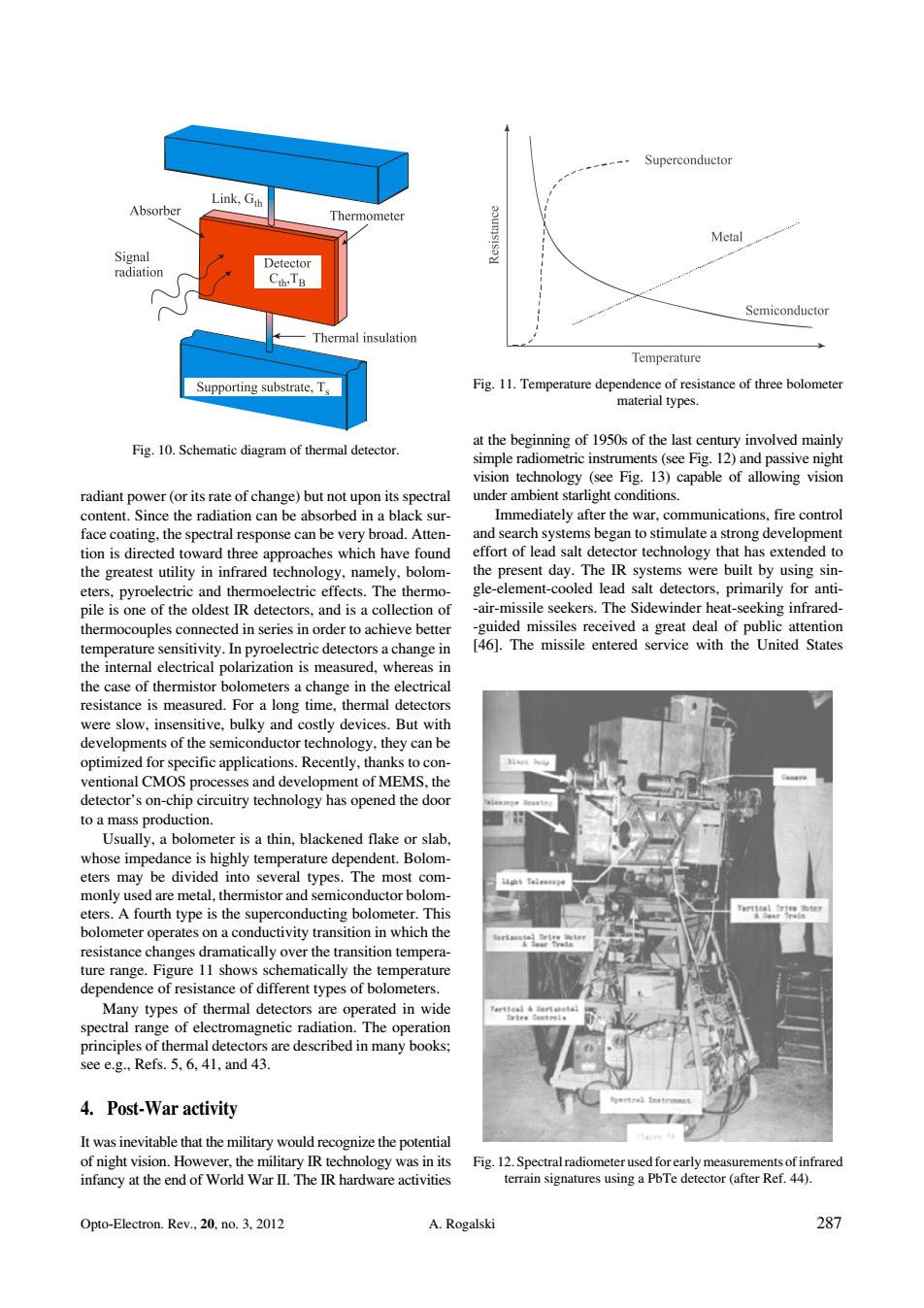正在加载图片...

雪 Metal 11 material types 1950s of the la change)bur not the war.c munications.fire control face coating,the spectral response can be very d.Atten n search systems began to stimulate a strong developmen on is direct rd three approaches The therr ment-cooled lead salt detectors,primarily for anti pile is one of the oldest IR detectors.and isac tion o s conne 4).The missile entered service with the United States measured.whe eters a change in【 electrica opments of the semiconductor technology,they can be ned flake whose impedance is highly ter ture de into several types.The most com fourth is the This bolometer operates on a cor mgsionnwhebte dep principles of thermal detecto s are described in many books: sce e.g.Refs.5.6,41,and 43. 4.Post-War activity It was inevitable that the military would recognize the potential Opto-Electron.Rev.20.no 3 2012 A.Rogalski 287 radiant power (or its rate of change) but not upon its spectral content. Since the radiation can be absorbed in a black sur− face coating, the spectral response can be very broad. Atten− tion is directed toward three approaches which have found the greatest utility in infrared technology, namely, bolom− eters, pyroelectric and thermoelectric effects. The thermo− pile is one of the oldest IR detectors, and is a collection of thermocouples connected in series in order to achieve better temperature sensitivity. In pyroelectric detectors a change in the internal electrical polarization is measured, whereas in the case of thermistor bolometers a change in the electrical resistance is measured. For a long time, thermal detectors were slow, insensitive, bulky and costly devices. But with developments of the semiconductor technology, they can be optimized for specific applications. Recently, thanks to con− ventional CMOS processes and development of MEMS, the detector’s on−chip circuitry technology has opened the door to a mass production. Usually, a bolometer is a thin, blackened flake or slab, whose impedance is highly temperature dependent. Bolom− eters may be divided into several types. The most com− monly used are metal, thermistor and semiconductor bolom− eters. A fourth type is the superconducting bolometer. This bolometer operates on a conductivity transition in which the resistance changes dramatically over the transition tempera− ture range. Figure 11 shows schematically the temperature dependence of resistance of different types of bolometers. Many types of thermal detectors are operated in wide spectral range of electromagnetic radiation. The operation principles of thermal detectors are described in many books; see e.g., Refs. 5, 6, 41, and 43. 4. Post-War activity It was inevitable that the military would recognize the potential of night vision. However, the military IR technology was in its infancy at the end of World War II. The IR hardware activities at the beginning of 1950s of the last century involved mainly simple radiometric instruments (see Fig. 12) and passive night vision technology (see Fig. 13) capable of allowing vision under ambient starlight conditions. Immediately after the war, communications, fire control and search systems began to stimulate a strong development effort of lead salt detector technology that has extended to the present day. The IR systems were built by using sin− gle−element−cooled lead salt detectors, primarily for anti− −air−missile seekers. The Sidewinder heat−seeking infrared− −guided missiles received a great deal of public attention [46]. The missile entered service with the United States Opto−Electron. Rev., 20, no. 3, 2012 A. Rogalski 287 Fig. 10. Schematic diagram of thermal detector. Fig. 11. Temperature dependence of resistance of three bolometer material types. Fig. 12. Spectral radiometer used for early measurements of infrared terrain signatures using a PbTe detector (after Ref. 44)